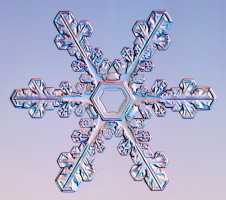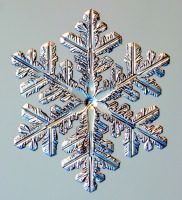 Now there's a question I hear a lot. It's a funny question, almost
like a Zen koan -- if two identical snowflakes fell, my
inquisitive friend, who would know? And can you ever be sure that
no two are alike, since you cannot check them all to find out?
Now there's a question I hear a lot. It's a funny question, almost
like a Zen koan -- if two identical snowflakes fell, my
inquisitive friend, who would know? And can you ever be sure that
no two are alike, since you cannot check them all to find out?
Although there is indeed a certain level of unknowability to the
question of snowflake alikeness, as a physicist I find that I can
address this issue with some confidence. As I will demonstrate,
the answer depends to a large degree on what you mean by the question.
(Yes, physics does occasionally have its Zen-like qualities.)
The short answer to the question is yes
-- it is indeed extremely unlikely that two complex snowflakes will look exactly
alike. It's so extremely unlikely, in fact, that even if you
looked at every one ever made you would not find any exact duplicates.
The long answer is a bit more involved -- it depends on just what
you mean by "alike," and on just what you mean by "snowflake."
Let's look at the possibilities....
Nano-snowflakes can be exactly alike.
Some things in Nature are exactly alike. For example, our understanding of
elementary particles indicates that all electrons are exactly,
precisely the
same. This is one of the cornerstones of quantum physics, and if you think for a bit you will see that this is a
profound statement. Electrons are true elementary particles, in that they have no
component parts; thus they are all exactly alike.
A water molecule is considerably more complex than an electron, and not all
water molecules are exactly alike. If we restrict ourselves to water molecules which
contain two ordinary hydrogen atoms and one ordinary 16O atom, then again
physics tells us that all such water molecules are exactly alike. However
about one molecule out of every 5000 naturally occurring water molecules will contain an
atom of deuterium in place of one of the hydrogens, and about one in 500 will contain an
atom of 18O instead of the more common 16O. These rogues are
not exactly the same as their more common cousins.
Since a typical small snow crystal might contain 1018 water molecules,
we see that about 1015 of these molecules will be different from the
rest. These unusual molecules will be randomly scattered throughout the snow
crystal, giving it a unique design. The probability that two snow crystals would
have exactly the same layout of these molecules is very, very, very small.
Even with 1024 crystals per year, the odds of it happening within the lifetime
of the Universe is indistinguishable from zero.
Thus at some very pure level, no two snow crystals are exactly alike. An exception (why does there always have to be an exception?) would be a snow crystal with
only a handful of molecules. If we assemble a crystal of only 10 molecules, for
example, then it's not so unlikely that each of the 10 will contain two ordinary hydrogen
atoms and one ordinary 16O atom. Furthermore, a cluster of only 10
molecules will only have a few likely configurations. So there's a reasonable
probability that two 10-molecule snow crystals would be exactly alike.
I might add that even if we restrict ourselves to isotopically pure water
molecules, it's still very, very unlikely that two macroscopic snow crystals would be exactly
alike. When a crystal grows, the molecules do not stack together with perfect
regularity, so a typical snow crystal contains a huge number of crystal dislocations,
which again are scattered throughout the crystal in a random fashion. One can then
argue, like with the isotopes, that the probability of two crystals growing with exactly
the same pattern of dislocations is vanishingly small. Again one has the exception
of few-molecule crystals, which can easily be free of dislocations.
 Small snow crystals can look alike. Now let's relax our definition of alikeness, and say that two snow
crystals are alike if they just look alike in an optical
microscope (the smallest features one can see in an optical microscope
are about one micrometer in size, which is about 10000 times larger than
an atom). In this case things are very
different. One can find simple
hexagonal prisms falling from the sky,
and one can certainly make such simple crystals in the lab. The picture here shows
two such crystals grown using the free-fall method (see Free-falling
Snow). Small snow crystals can look alike. Now let's relax our definition of alikeness, and say that two snow
crystals are alike if they just look alike in an optical
microscope (the smallest features one can see in an optical microscope
are about one micrometer in size, which is about 10000 times larger than
an atom). In this case things are very
different. One can find simple
hexagonal prisms falling from the sky,
and one can certainly make such simple crystals in the lab. The picture here shows
two such crystals grown using the free-fall method (see Free-falling
Snow).
Crystals with simple shapes often look similar to one
another, and it's not hard to imagine that if you sifted through a
reasonable number of Antarctic snow crystals you would find two that
were essentially indistinguishable in a microscope. Since simple
crystals are very common (one doesn't notice them much because
they're small), it's fair to say that there are a great many natural snow crystals that
look pretty much alike.
But that's only for simple hexagonal prisms. What about more
complex stellar crystals?
 Larger,
complex snowflakes are all different. The number of possible ways of making a
complex snowflake is staggeringly large. To see just how much so,
consider a simpler question -- how many ways can you arrange 15 books on
your bookshelf? Well, there's 15 choices for the first book, 14
for the second, 13 for the third, etc. Multiply it out and there
are over a trillion ways to arrange just 15 books. With a hundred
books, the number of possible arrangements goes up to just under 10158
(that's a 1 followed by 158 zeros).
That number is about 1070 times larger than the total number
of atoms in the entire universe! Larger,
complex snowflakes are all different. The number of possible ways of making a
complex snowflake is staggeringly large. To see just how much so,
consider a simpler question -- how many ways can you arrange 15 books on
your bookshelf? Well, there's 15 choices for the first book, 14
for the second, 13 for the third, etc. Multiply it out and there
are over a trillion ways to arrange just 15 books. With a hundred
books, the number of possible arrangements goes up to just under 10158
(that's a 1 followed by 158 zeros).
That number is about 1070 times larger than the total number
of atoms in the entire universe!
Now when you look at a complex snow crystal, you can often pick out
a hundred separate features if you look closely. Since all those
features could have grown differently, or ended up in slightly different
places, the math is similar to that with the books. Thus the
number of ways to make a complex snow crystal is absolutely huge.
And thus it's unlikely that any two complex snow crystals, out of all
those made over the entire history of the planet, have ever looked completely alike.
|
